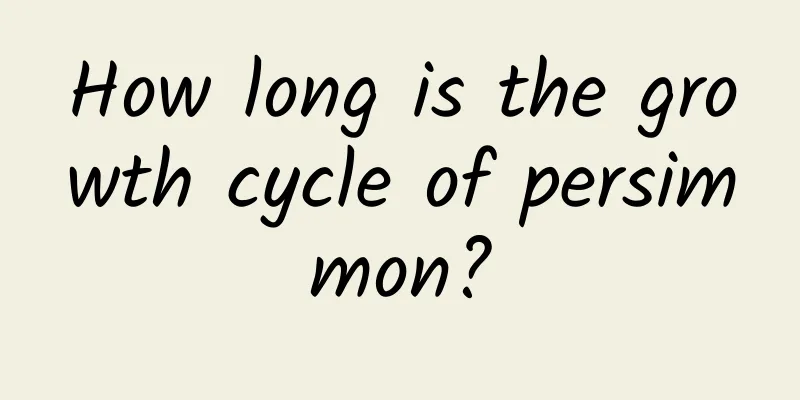How long is the growth cycle of persimmon?

Persimmon Growth IntroductionPersimmon tree is a positive tree species. It likes to grow in warm climates and sunny environments. It grows well in deep, fertile, moist and well-drained soil. It is suitable for neutral soil and is cold-resistant, barren-resistant and drought-resistant. The native place of persimmon tree is in the Yangtze River Basin of my country. It is now cultivated in western Liaoning, southern Gansu, Sichuan, Yunnan, Taiwan Province, etc. It is also planted in North Korea, Japan, Southeast Asia, Oceania, Algeria in North Africa, France, the Soviet Union, the United States, etc. Persimmon growth cycleThe growing period of a persimmon tree generally refers to the period from the time the grafting is successful to the time the tree bears its first fruit. During this period, the tree mainly grows nutritionally. The growing period of a persimmon tree is generally 2-5 years, and it will begin to bear fruit at this time. Persimmon growth rateIn spring, the persimmon tree will grow many young buds. As it continues to grow, it will turn into small leaves in summer. When autumn approaches, small persimmons will grow at the roots of the leaves. After September, they will gradually grow and mature. Persimmon trees will start bearing fruit 5 to 6 years after grafting, and will enter the peak fruit-bearing period 10 to 12 years after planting. Its seedling trees bear fruit later, about 7 to 8 years after sowing. Persimmon Growth Cycle ManagementThe yield of persimmon trees in their peak production period is 4,000 to 5,000 kilograms per mu. After years of cultivation, there are many varieties, so the yield is not the same, and each stage has its own characteristics. The growth process of persimmon trees is divided into several stages: growth period, early fruiting period, peak fruiting period, and aging period. Temperature management: The annual average temperature of persimmon trees is 10-21.5℃, and the most suitable annual average temperature is 13℃-19℃. Within this range, there is no frost damage in winter and no sunburn in summer. Flower buds are easily formed and the fruit quality is good. Fertilization management: Persimmon fertilization is generally divided into two types: base fertilizer and topdressing. The specific situation depends on the variety, fertilizer requirements, and tree growth and fruiting conditions. Generally, it is best to apply fertilizer four times a year. |
<<: How long is the growth cycle of bayberry?
>>: Can hand-twisted gourds be potted?
Recommend
How to propagate millet grass through sowing
Seed propagation of eyebright grass Seed selectio...
What are the legends and meanings of daffodils?
1. The language and meaning of daffodils 1. Flowe...
Management methods of Amaryllis in four seasons
Spring Management Amaryllis is a bulbous plant. I...
Where does Sichuan pepper come from in Shaanxi and how to breed it?
1. Origin Shaanxi peppercorns can be said to be v...
Cultivation methods and precautions of hydroponic Mo Lan
1. Breeding methods 1. Light: It likes semi-shady...
The difference between physalis and violet physalis
1. Different varieties There are many types of ge...
How to prune the elmleaf plum
Method of pruning the main branches of Prunus arm...
How to prune passion fruit? Techniques and methods
Passion fruit pruning time Passion fruit can be p...
Can I grow a peach tree at home?
Can I grow peach trees at home? Peach trees can b...
How to prune Rieger Begonia
The necessity of pruning Rieger Begonia The branc...
How to grow orchids with weak seedlings and few roots? What kind of planting material is good?
1. Breeding methods 1. Temperature: Weak orchid s...
Chia seeds seven-day weight loss method, how to eat chia seeds to lose weight quickly
1. Chia seeds seven-day weight loss method Take o...
How to propagate moonflower
Moonflower breeding requirements Since we are tal...
What is the use of red tassel flower
Introduction to Red Tassel Flower The red twig is...
What flowers are suitable for the living room?
1. Aloe Vera Aloe vera's purification ability...









